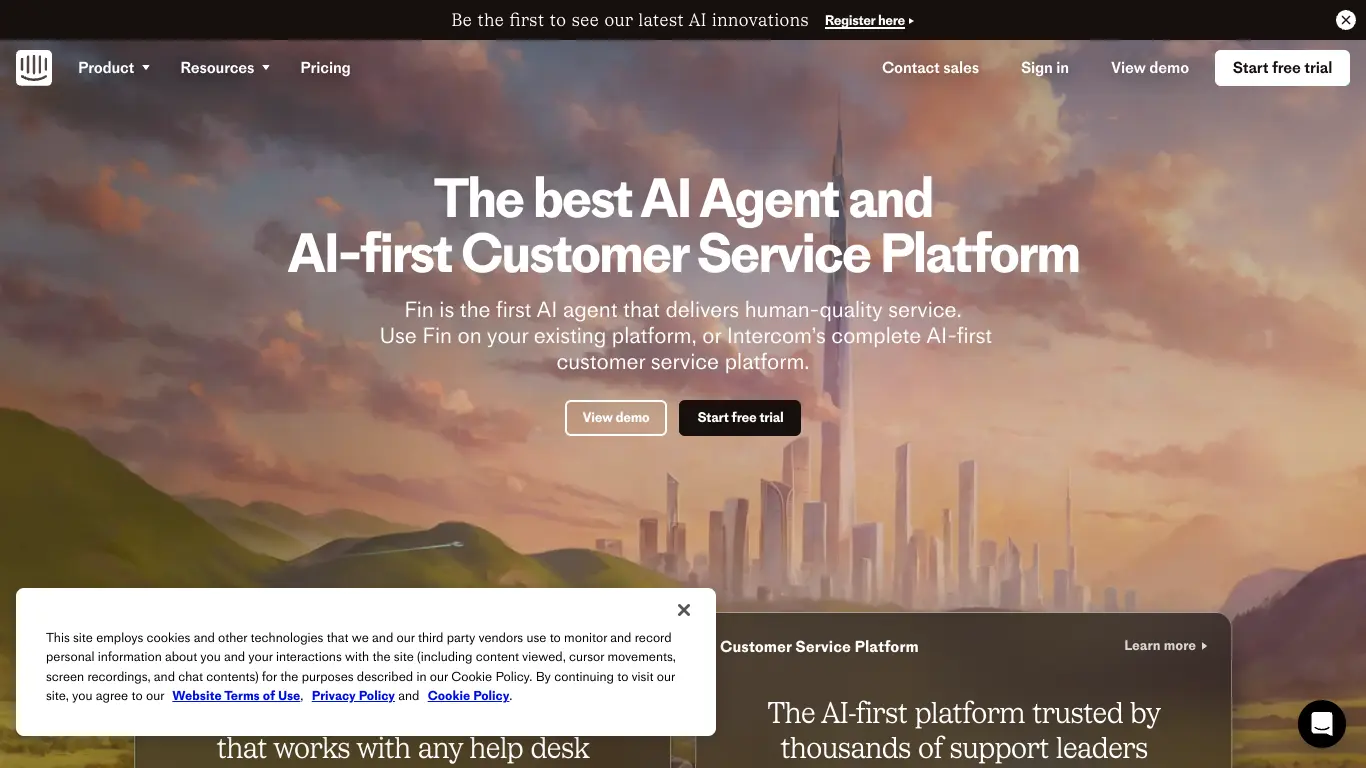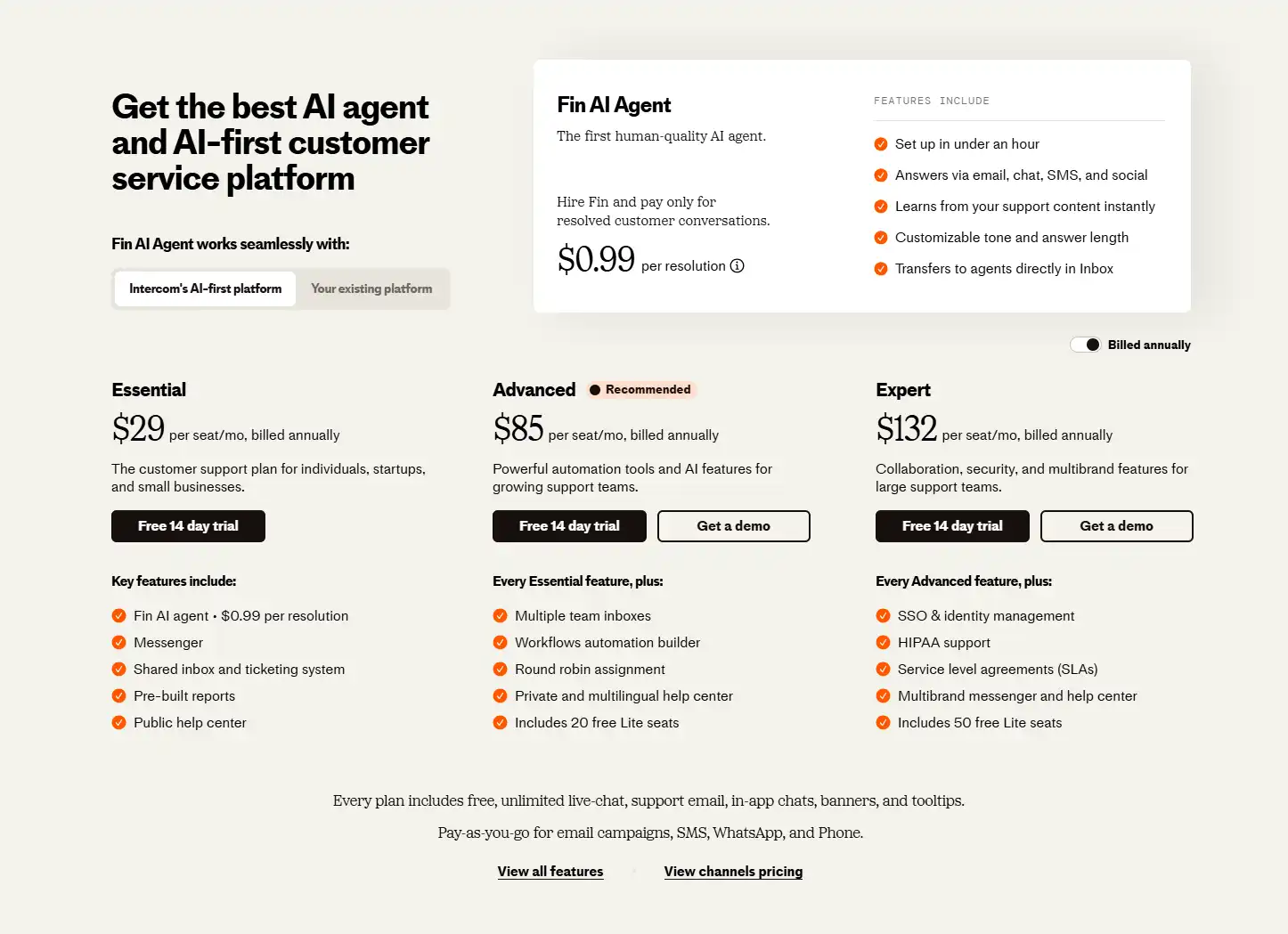Intercom combines messaging, automation and support tools to help businesses build better customer relationships across the entire journey.
Intercom
 If you’ve ever found yourself juggling multiple communication channels, losing track of customer conversations, or struggling to provide timely support, you’re not alone. These pain points affect businesses of all sizes, and the frustration can be overwhelming. That’s where Intercom enters the picture—a solution designed to transform how businesses communicate with their customers. But is it the right tool for your specific needs? Let’s dive deep into what makes Intercom tick and whether it deserves a place in your tech stack.
If you’ve ever found yourself juggling multiple communication channels, losing track of customer conversations, or struggling to provide timely support, you’re not alone. These pain points affect businesses of all sizes, and the frustration can be overwhelming. That’s where Intercom enters the picture—a solution designed to transform how businesses communicate with their customers. But is it the right tool for your specific needs? Let’s dive deep into what makes Intercom tick and whether it deserves a place in your tech stack.
Introduction to Intercom
What is Intercom and its Purpose?
Intercom is a comprehensive customer communications platform that bridges the gap between businesses and their customers. At its core, Intercom combines messaging, automation, and support tools into a unified system that enables personalized communication at scale.
Unlike traditional communication tools that operate in silos, Intercom takes an integrated approach. It allows teams to engage with customers throughout their entire journey—from the moment they first visit your website, through the sales process, and continuing long after they become customers. This holistic approach helps businesses build stronger relationships while improving operational efficiency.
The platform serves three main purposes:
- 🗣️ Customer Engagement: Proactively reaching out to customers with targeted messages
- 🤖 Customer Support: Resolving customer issues quickly and efficiently
- 🔄 Customer Retention: Nurturing existing relationships to reduce churn
With its AI-powered capabilities, Intercom isn’t just about facilitating conversations—it’s about making those conversations more meaningful, timely, and effective.
Who is Intercom Designed For?
Intercom caters to a diverse range of businesses, but it particularly shines in certain environments:
SaaS Companies: For software-as-a-service businesses, Intercom offers specialized tools to onboard users, address technical issues, and gather product feedback.
E-commerce Businesses: Online retailers can leverage Intercom to guide shoppers through purchases, recover abandoned carts, and handle post-purchase support.
B2B Organizations: Companies selling to other businesses benefit from Intercom’s ability to nurture leads, facilitate sales conversations, and maintain client relationships.
Within these organizations, Intercom serves multiple departments:
- 👨💼 Marketing Teams: For building campaigns and capturing leads
- 👩💻 Support Teams: For handling customer inquiries efficiently
- 🧑💼 Sales Teams: For converting prospects into customers
- 👨🔬 Product Teams: For collecting user feedback and insights
Intercom works best for businesses that value customer relationships and are willing to invest in meaningful engagement rather than one-off transactions.
Getting Started with Intercom: How to Use It
Getting up and running with Intercom involves a straightforward process:
- Sign Up: Create an account on the Intercom website
- Install the Code: Add a simple JavaScript snippet to your website or app
- Set Up Your Inbox: Configure your team and routing preferences
- Create Your First Bot: Build automated workflows to handle common scenarios
- Customize Your Messenger: Tailor the look and feel to match your brand
The platform’s onboarding experience guides you through these steps with interactive tutorials and suggestions based on your business type. Within minutes, you can have a functional communication system that begins collecting visitor data and enabling conversations.
Intercom’s interface is intuitive enough that non-technical team members can easily manage day-to-day operations, while developers appreciate the robust API for deeper customizations.
Intercom’s Key Features and Benefits
Core Functionalities of Intercom
Intercom’s platform consists of several interconnected products that work together seamlessly:
Intercom Messenger: The customizable chat widget that appears on your website or in your app, serving as the primary touchpoint for customer interactions. It supports rich media, including images, videos, and apps.
Business Inbox: A centralized hub where teams can manage all customer conversations across channels. The inbox includes features like assignments, private notes, and collision detection to prevent multiple agents from responding to the same query.
Custom Bots and AI: Automated assistants that can handle common questions, qualify leads, and route conversations to the right team members. Intercom’s AI capabilities have grown significantly, with their “Fin” AI assistant now capable of resolving many issues without human intervention.
Outbound Messaging: Tools for creating targeted campaigns via in-app messages, emails, push notifications, and more. These can be triggered by user behavior or scheduled for specific times.
Help Center: A knowledge base solution that allows businesses to create self-service support content, reducing the volume of repetitive questions.
Product Tours: Guided walkthroughs that help users discover and adopt key features in your product, improving activation and retention.
Team Management: Robust tools for organizing support teams, setting working hours, and managing workload distribution.
Advantages of Using Intercom
The benefits of implementing Intercom extend across multiple dimensions of business performance:
Increased Efficiency: Automation handles routine inquiries, freeing up human agents to focus on complex issues that require personal attention. According to Intercom’s case studies, businesses typically see a 33% reduction in response times after implementation.
Enhanced Customer Experience: The seamless, conversational interface matches modern consumer expectations. Customers can get help without leaving your website or app, reducing friction in the support process.
Data-Driven Insights: Intercom captures valuable data about customer interactions, providing actionable intelligence to improve products and services. These insights help businesses identify pain points and opportunities.
Scalability: As your business grows, Intercom grows with you. The platform can handle increasing volumes of conversations without requiring proportional increases in staff.
Reduced Churn: Proactive engagement and timely support help identify at-risk customers before they leave. Many Intercom users report significant improvements in retention metrics.
Team Collaboration: The platform facilitates better coordination between departments, ensuring consistent customer experiences regardless of which team member is involved.
Main Use Cases and Applications
Intercom’s versatility allows it to address numerous business challenges:
Live Chat Support: Real-time assistance for customers navigating your website or experiencing issues with your product.
Lead Qualification: Automated conversations that identify promising prospects and connect them with sales representatives.
User Onboarding: Guided experiences that help new users get value from your product quickly, increasing activation rates.
Proactive Engagement: Targeted messages based on user behavior, such as offering assistance to someone who appears stuck on a page.
Customer Feedback Collection: Structured surveys and open-ended conversations that gather insights for product improvement.
Re-engagement Campaigns: Strategic outreach to inactive users, encouraging them to return and continue using your product.
Cross-selling and Upselling: Contextual promotions that introduce existing customers to additional products or premium features.
A particularly powerful application is setting up what Intercom calls “Resolution Bots” – AI assistants that can understand customer queries and resolve up to 50% of routine support questions without human intervention, operating 24/7.
Exploring Intercom’s Platform and Interface
User Interface and User Experience
Intercom’s interface strikes a balance between comprehensive functionality and usability:
Dashboard Design: The clean, intuitive dashboard provides a bird’s-eye view of key metrics and recent activities. Cards display important information at a glance, with the ability to drill down for details.
Conversation Interface: The messaging workspace resembles familiar chat applications, making it comfortable for team members to adopt. Additional context about the customer appears in a sidebar, providing relevant information without cluttering the main view.
Campaign Builder: Creating automated message sequences involves a visual workflow editor with drag-and-drop functionality. This approach makes complex automation accessible to non-technical users.
Mobile Responsiveness: Intercom offers dedicated mobile apps for iOS and Android, allowing team members to manage conversations on the go. The apps maintain most of the desktop functionality while optimizing for smaller screens.
Customization Options: Extensive visual customization allows businesses to align the customer-facing elements with their brand identity. This includes colors, logos, and tone of voice in automated messages.
The user experience reflects Intercom’s own product philosophy: sophisticated capabilities presented in an approachable way. The learning curve is relatively gentle for basic functions, with more advanced features becoming accessible as users gain confidence.
Platform Accessibility
Intercom demonstrates a commitment to accessibility across several dimensions:
Device Compatibility: The platform works consistently across desktop computers, tablets, and smartphones. This flexibility ensures team members can stay connected regardless of their work environment.
Browser Support: Intercom functions properly in all major web browsers, including Chrome, Firefox, Safari, and Edge.
API and Integrations: For businesses with unique requirements, Intercom provides a robust API and webhooks system. This openness allows for custom integrations and workflows beyond the standard feature set.
Language Support: The platform supports multiple languages, both in the team interface and in customer communications. This multilingual capability is crucial for businesses with international operations.
Accessibility Compliance: Intercom has made efforts to ensure their product meets accessibility standards, including keyboard navigation and screen reader compatibility.
One particularly notable aspect of Intercom’s accessibility is its extensive documentation and learning resources. The Help Center, webinars, and certification programs help teams maximize their use of the platform, regardless of their prior experience with similar tools.
Intercom Pricing and Plans
Subscription Options
Intercom structures its pricing around three main plans, each tailored to different business needs:

For businesses on a tight budget, it’s essential to evaluate which features are truly necessary for your current stage. Many organizations start with the Starter plan and upgrade as their needs evolve and ROI becomes evident.
Intercom Reviews and User Feedback
Pros and Cons of Intercom
Based on analysis of user reviews across multiple platforms, here’s a balanced assessment of Intercom’s strengths and limitations:
Pros:
- 🌟 Unified Platform: The integrated nature of Intercom eliminates the need for multiple tools, creating a cohesive customer experience.
- 🌟 Ease of Implementation: The simple installation process gets businesses up and running quickly.
- 🌟 Automation Capabilities: Powerful workflows reduce manual effort while maintaining personalization.
- 🌟 Interface Quality: Both internal and customer-facing interfaces are polished and intuitive.
- 🌟 Constant Innovation: Regular feature updates keep the platform competitive in a rapidly evolving market.
Cons:
- ❗ Pricing Structure: Many users report that costs can escalate quickly as contact bases grow.
- ❗ Feature Complexity: The abundance of options can be overwhelming for smaller teams.
- ❗ Mobile Limitations: Some advanced features have reduced functionality on mobile devices.
- ❗ Learning Curve: Mastering all aspects of the platform requires significant time investment.
- ❗ Support Response Times: Some users mention delays in getting help with complex issues.
G2, a leading business software review platform, shows Intercom with an overall rating of 4.4/5 stars based on over 2,500 reviews, indicating generally positive sentiment despite the limitations.
User Testimonials and Opinions
Real feedback from Intercom users provides valuable perspective on the platform’s practical impact:
“Intercom transformed our support operation from reactive to proactive. We’re now able to identify and address potential issues before customers even need to reach out.” – Marketing Director at a mid-size SaaS company
“The ROI was almost immediate. Within three months, we reduced our support ticket volume by 35% through automation and self-service options, while improving our customer satisfaction scores.” – Head of Customer Experience at an e-commerce business
“Implementation was surprisingly painless, but the ongoing cost as we’ve grown has been challenging to justify to finance. Great product, but be prepared for the price tag.” – Startup Founder
“The analytics capabilities have revealed patterns we never noticed before. We’ve been able to identify specific user behaviors that indicate risk of churn and intervene appropriately.” – Customer Success Manager
Common themes in user feedback include appreciation for the platform’s comprehensiveness and design quality, balanced against concerns about cost-effectiveness for smaller organizations and the time required to fully utilize all features.
Intercom Company and Background Information
About the Company Behind Intercom
Intercom was founded in 2011 by Eoghan McCabe, Des Traynor, Ciaran Lee, and David Barrett. The company emerged from the founders’ own frustrations with existing customer communication tools while working on previous projects.
Company Growth Timeline:
- 2011: Founded in Dublin, Ireland
- 2012: Raised $1.75 million seed funding
- 2013: Expanded to San Francisco
- 2015: Reached 5,000 paying customers
- 2018: Achieved unicorn status with $1.25 billion valuation
- 2020: Introduced Resolution Bot and expanded AI capabilities
- 2022: Reached over 25,000 paying customers
- 2023: Continued expansion of AI-powered features with “Fin”
Intercom maintains headquarters in both San Francisco and Dublin, with additional offices in London, Sydney, and Chicago. This global presence reflects the company’s international customer base and commitment to diverse perspectives.
The company culture emphasizes product-led growth and customer centricity. This philosophy is evident in how Intercom uses its own product extensively for customer engagement, essentially “eating their own dog food” and testing new features internally before releasing them to customers.
Intercom has raised over $240 million in funding from notable investors including Kleiner Perkins, Google Ventures, and Bessemer Venture Partners. This substantial financial backing has enabled the company to invest heavily in product development and innovation.
Intercom Alternatives and Competitors
Top Intercom Alternatives in the Market
If you’re evaluating Intercom, consider these leading alternatives that address similar needs but with different approaches:
Zendesk: A comprehensive customer service platform with a strong focus on ticketing systems and extensive integration capabilities. Ideal for larger organizations with complex support needs.
Website: https://www.zendesk.com/
Drift: Specializes in conversational marketing and sales, with particular strength in lead generation and qualification. Popular among B2B companies with longer sales cycles.
Website: https://www.drift.com/
Freshchat: Part of the Freshworks suite, offering chat functionality with a straightforward interface and affordable pricing. Well-suited for small to medium businesses.
Website: https://www.freshworks.com/live-chat-software/
Help Scout: Focused on email-based customer support with a clean, distraction-free interface. Appeals to teams that prefer a more traditional support approach.
Website: https://www.helpscout.com/
Crisp: A streamlined alternative with competitive pricing and essential features for startups and small businesses.
Website: https://crisp.chat/
HubSpot Service Hub: Part of HubSpot’s broader marketing, sales, and service platform, offering solid integration with other business functions.
Website: https://www.hubspot.com/products/service
Each alternative has its own distinct focus and strengths, making the best choice dependent on your specific business needs and priorities.
Intercom vs. Competitors: A Comparative Analysis
To help visualize how Intercom stacks up against key competitors, here’s a feature comparison table:
| Feature | Intercom | Zendesk | Drift | Freshchat | Help Scout |
|---|---|---|---|---|---|
| Live Chat | ✅ | ✅ | ✅ | ✅ | ⚠️ Limited |
| Chatbots/AI | ✅ Advanced | ✅ Advanced | ✅ Advanced | ✅ Basic | ❌ |
| Email Support | ✅ | ✅ | ⚠️ Limited | ✅ | ✅ Strong |
| Knowledge Base | ✅ | ✅ | ⚠️ Basic | ✅ | ✅ |
| Product Tours | ✅ | ❌ | ❌ | ❌ | ❌ |
| Outbound Messaging | ✅ Strong | ⚠️ Basic | ✅ | ⚠️ Basic | ❌ |
| Mobile Apps | ✅ | ✅ | ✅ | ✅ | ✅ |
| Free Plan | ❌ | ✅ | ✅ | ✅ | ❌ |
| Starting Price | $74/mo | $49/mo | $40/mo | $15/mo | $20/mo |
Where Intercom Excels:
- Unified platform for marketing, sales, and support
- Superior in-product messaging capabilities
- Strong automation across the entire customer journey
- Product tours and onboarding features
Where Competitors May Have an Edge:
- Zendesk offers more robust ticketing for complex support processes
- Drift provides more specialized B2B sales tools
- Freshchat and Crisp deliver core functionality at lower price points
- Help Scout excels in email-based support workflows
The right choice depends on your company’s priorities. If you value an integrated approach to customer communication across departments, Intercom likely has an advantage. If you’re primarily focused on a specific function (like support ticketing or sales conversations) or have significant budget constraints, one of the alternatives might be more appropriate.
Intercom Website Traffic and Analytics
Website Visit Over Time
Intercom’s web presence shows consistent growth and strong market position. According to traffic analysis tools, intercom.com typically receives between 1.5-2 million monthly visits, reflecting its established position in the customer communication space.
Traffic trends show seasonal fluctuations, with peaks often occurring during Q1 and Q4 when businesses typically reevaluate and implement new software solutions. There’s also noticeable traffic spikes following major product announcements and marketing campaigns.
The website demonstrates healthy engagement metrics:
- Average session duration: 3-4 minutes
- Pages per session: 3-5 pages
- Bounce rate: 45-55%
These figures suggest visitors are finding valuable content and exploring the site beyond their initial landing page.
Geographical Distribution of Users
Intercom’s user base spans the globe, with particularly strong presence in certain regions:
- North America: 40-45% of traffic (with the United States accounting for approximately 35%)
- Europe: 30-35% (particularly strong in the UK, Ireland, Germany, and France)
- Asia-Pacific: 15-20% (with significant usage in Australia, India, and Singapore)
- Rest of World: 5-10%
This distribution aligns with Intercom’s office locations and marketing focus, though the platform continues to expand its global presence.
Main Traffic Sources
Understanding how visitors discover Intercom provides insight into the company’s marketing effectiveness:
Organic Search: 45-50% of traffic comes through search engines, indicating strong SEO performance and brand recognition. Key search terms include “customer messaging platform,” “live chat software,” and “customer communication tools.”
Direct Traffic: 20-25% of visitors type the URL directly or use bookmarks, suggesting strong brand awareness and returning visitors.
Referral Traffic: 15-20% arrives from other websites, with significant contributions from review platforms like G2 and Capterra, as well as technology partners.
Social Media: 5-10% comes through social channels, with LinkedIn driving the majority of this traffic, followed by Twitter and Facebook.
Paid Search: 5-10% results from advertising campaigns, primarily on Google and industry-specific platforms.
This diverse traffic mix demonstrates a well-rounded marketing strategy that doesn’t overly depend on any single channel.
Frequently Asked Questions about Intercom (FAQs)
General Questions about Intercom
Q: What exactly is Intercom?
A: Intercom is a customer communications platform that combines messaging, automation, and support tools to help businesses build better customer relationships. It provides a unified system for engaging with customers throughout their journey.
Q: Is Intercom suitable for small businesses?
A: While Intercom offers solutions for businesses of all sizes, the cost structure may be challenging for very small organizations. The Starter plan provides essential features, but costs increase with contact volume and team size. Small businesses should evaluate ROI carefully.
Q: Does Intercom work on mobile apps?
A: Yes, Intercom provides SDKs for iOS and Android that allow you to integrate the messenger into your mobile applications. This enables consistent customer communication across web and mobile platforms.
Q: How long does it take to implement Intercom?
A: Basic implementation can be completed in minutes by adding a JavaScript snippet to your website. However, a more strategic setup including automations, team workflows, and integrations typically takes 1-2 weeks for full optimization.
Feature Specific Questions
Q: Can Intercom handle support tickets?
A: While Intercom doesn’t use traditional ticket numbers, its conversation-based system fulfills the same function. Conversations can be assigned, prioritized, and tracked with internal notes and status updates.
Q: How effective is Intercom’s AI chatbot?
A: Intercom’s AI-powered Resolution Bot can handle approximately 33-50% of routine inquiries without human intervention, according to company data. The effectiveness increases over time as the AI learns from interactions.
Q: Can Intercom integrate with my CRM?
A: Yes, Intercom offers native integrations with popular CRMs including Salesforce, HubSpot, and Pipedrive. For other systems, the Intercom API and platforms like Zapier enable custom connections.
Q: Is it possible to segment customers in Intercom?
A: Absolutely. Intercom provides powerful segmentation capabilities based on user attributes, behaviors, and interactions. These segments can be used for targeted messaging, support prioritization, and analytics.
Pricing and Subscription FAQs
Q: Does Intercom charge based on the number of users?
A: Intercom’s pricing is based on a combination of factors: the number of seats (team members using the platform), the number of active contacts in your database, and the specific features/add-ons you need.
Q: Is there a contract or minimum commitment?
A: Intercom offers both monthly and annual billing options. Annual plans typically come with a discount but require a 12-month commitment. Monthly plans offer more flexibility but at a higher cost.
Q: What happens if I exceed my contact limit?
A: If you exceed your plan’s contact limit, Intercom will continue functioning but will notify you about the overage. Persistent overages will result in automatic billing adjustments to the appropriate tier.
Q: Can I switch between plans?
A: Yes, you can upgrade or downgrade your plan as needed. Upgrades take effect immediately, while downgrades typically apply at the end of your current billing cycle.
Support and Help FAQs
Q: What kind of support does Intercom provide to its customers?
A: The level of support varies by plan. All customers have access to email support and the knowledge base. Pro and Premium plans include faster response times and access to dedicated support channels. Premium customers receive a dedicated Customer Success Manager.
Q: Is there training available for new users?
A: Intercom offers extensive onboarding resources, including guided product tours, webinars, documentation, and the Intercom Academy certification program. Premium customers receive personalized onboarding assistance.
Q: How frequently does Intercom release updates?
A: Intercom regularly updates its platform, with minor enhancements released weekly and larger features typically launching quarterly. The company maintains a public roadmap and release notes for transparency.
Q: Can I get help with strategy, not just technical issues?
A: Premium plan customers receive strategic guidance as part of their package. For other customers, Intercom offers consulting services and has a network of certified partners who can provide strategic support.
Conclusion: Is Intercom Worth It?
Summary of Intercom’s Strengths and Weaknesses
After thorough analysis, here’s a balanced assessment of Intercom’s value proposition:
Strengths:
- 🔹 Comprehensive all-in-one platform eliminating the need for multiple tools
- 🔹 Excellent user experience for both teams and customers
- 🔹 Powerful automation capabilities that scale with business growth
- 🔹 Strong AI implementation with practical applications
- 🔹 Regular innovation and feature enhancements
- 🔹 Robust integration ecosystem
Weaknesses:
- 🔸 Premium pricing that may challenge smaller organizations
- 🔸 Complex feature set requiring significant learning investment
- 🔸 Cost scaling that can accelerate rapidly with growth
- 🔸 Some specialized functions not as robust as dedicated single-purpose tools
- 🔸 Mobile experience sometimes lags behind desktop capabilities
Final Recommendation and Verdict
Intercom delivers exceptional value for:
- Mid-sized and growing businesses seeking a unified customer communication solution
- Companies prioritizing personalized, proactive customer engagement
- Organizations with collaborative teams across marketing, sales, and support
- Businesses willing to invest in relationship-building as a competitive advantage
Intercom may not be ideal for:
- Very small businesses with limited budgets
- Organizations needing highly specialized support workflows
- Companies looking for the absolute lowest-cost solution
- Teams without resources to fully implement and optimize the platform
The question of whether Intercom is “worth it” ultimately depends on your business priorities and resources. If building meaningful, efficient customer relationships is central to your strategy, Intercom provides a powerful toolset that justifies its cost through improved customer experience, operational efficiency, and retention.
For businesses on the fence, the 14-day trial offers a risk-free opportunity to evaluate the platform’s fit with your specific needs. Many organizations find that starting with essential features and expanding their usage as they grow provides the best path to maximizing ROI from Intercom.
In a world where customer experience increasingly determines business success, Intercom stands out as a comprehensive solution that helps companies communicate more effectively at every stage of the customer journey.



















